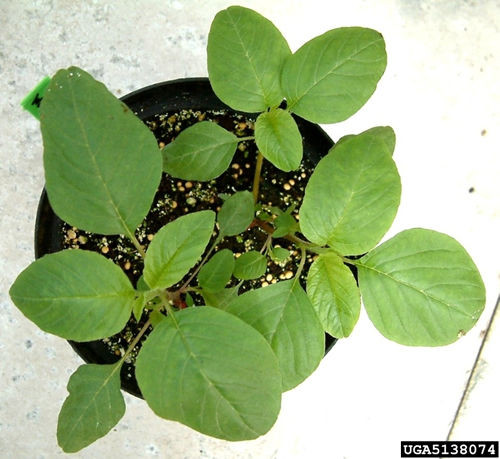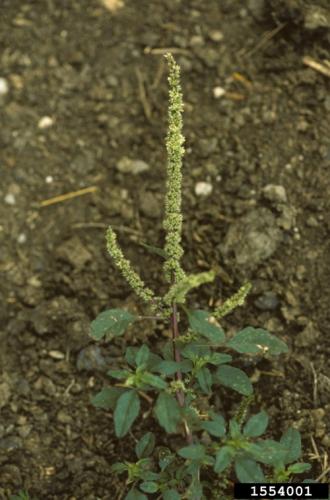eOrganic author:
Dr. Mark Schonbeck, Virginia Association for Biological Farming
Introduction
Powell amaranth, also known as green amaranth, is a fast-growing species that has become an important agricultural weed in cool temperate regions over the past 50 years (Uva et al, 1997). Native to dry, mountainous regions in the southwestern US and Mexico, this weed is now naturalized throughout temperate North America (Flora of North America; Mohler and DiTommaso, unpublished; Weaver & McWilliams, 1980), and its abundance relative to other pigweeds has increased in crop fields in Ontario, Canada (Weaver, 1984).
Powell amaranth is a tall, erect, branching summer annual, commonly reaching heights of 3–6 feet. Stems and foliage may be smooth, shiny, and lacking hairs (Fig. 1), or covered with fine hairs (Horak et al., 1994). On mature plants, leaves usually have petioles as long or longer than the leaf blade, and blades distinctly narrowing to a somewhat pointed tip. Blades are 1.6–3.5 inches long by ~ 1 inch wide, and have entire (smooth) margins.
a. 
b. 
Figure 1. a. Seedling, and b. older vegetative Powell amaranth, showing smooth, shiny upper leaf surfaces. Figure credits a. Joseph M. DiTomaso, University of California - Davis, Bugwood.org; b. Lynn Sosnoskie, University of Georgia, Bugwood.org.
Male and female flowers are borne together on the same plant (monoecious). The small (<0.25 inch) flowers are clustered tightly in stiff, branched terminal spikes, with the individual branches 4–8 inches long and thicker than a pencil (Horak et al., 1994) (Fig. 2). Seeds are about 0.05 inch long.

Figure 2. Powell amaranth in flower. Figure credit Ohio State Weed Lab Archive, The Ohio State University, Bugwood.org.
Powell amaranth is fairly variable, and is sometimes confused with redroot or smooth pigweeds. Identification may be further complicated by potential for hybridization with Palmer amaranth, redroot pigweed, and smooth pigweed (Old, 2008).
Biology
In growth chamber experiments conducted at cool (72°F day, 57°F night) and warmer (82°F day, 72°F night) temperatures, Powell amaranth germinated and grew more rapidly than either redroot pigweed or smooth pigweed (Weaver, 1984). In field experiments in Ontario, Powell amaranth showed greater growth, seed production, and competitive ability than the other two species. Compared to redroot pigweed, Powell amaranth has a lower temperature threshold for seed germination, and more tolerance for light frosts (Mohler and DiTommaso, unpublished), which may contribute to its adaptation to cool temperate regions. Both species formed mature seeds 3 weeks earlier than smooth pigweed.
Illinois populations of Powell amaranth seeds germinated fairly rapidly (in 1.5–3 days) over a wide temperature range (59–95°F) (Steckel et al., 2004). Unlike other weedy Amaranthus species, Powell amaranth seed germination showed little response to alternating temperatures. In upstate New York, seeds from Powell amaranth growing on dairy farms with a corn – alfalfa (multi-year) rotation were more dormant and longer lived than Powell amaranth seeds from fields under intensive vegetable production (Brainard et al., 2007). This suggests that the weed can adapt to different production systems, and perhaps to weed management tactics used year after year.
Powell amaranth grown with broccoli or broccoli + rye intercrop during a warm season responded to canopy shade with increased stem growth, whereas in a cooler season, the weed was more readily suppressed by crop competition (Brainard et al., 2005).
Powell amaranth responds to fertilization with increased growth and seed production (Mohler and DiTommaso, unpublished). A buckwheat green manure can suppress the emergence and growth of Powell amaranth, partly through removal of available soil N by the growing crop, and partly through allelopathic compounds released by decaying buckwheat residues (Kumar et al., 2008, 2009).
Management Implications for Organic Production
Results of the Ontario studies suggest that, in cool climates, Powell amaranth may grow faster and compete more aggressively against crops than other pigweed species. Nevertheless, the seedlings remain small and susceptible to cultivation for several weeks, and timely cultivations during late spring and early summer, followed by organic mulch, have been found effective for managing Powell amaranth in upstate New York (Mohler and DiTommaso, unpublished).
Other tactics described elsewhere for pigweeds, especially nutrient management and diversified crop rotation, are recommended for managing Powell amaranth.
References
Brainard, D. C., R. R. Bellinder, and A. DiTommaso. 2005. Effects of canopy shade on the morphology, phenology, and seed characteristics of Powell amaranth (Amaranthus powellii). Weed Science 53: 175-186.
Brainard, D. C., A. DiTommaso, and C. L. Mohler. 2007. Intraspecific variation in seed characteristics of Powell Amaranth (Amaranthus powellii) from habitats with contrasting crop rotation histories.
Flora of North America. On-line entry for Powell amaranth at: http://www.efloras.org/florataxon.aspx?flora_id=1&taxon_id=242415662.
Horak, M. J., D. E. Peterson, D. J. Chessman, and L. M. Wax. 1994. Pigweed Identification: a Pictoral Guide to the Common Pigweeds of the Great Plains. 12 pp. www.ksre.ksu.edu/library/crpsl2/s80.pdf
Kumar, V., D. C. Brainard, and R. R. Bellinder. 2008. Suppression of Powell amaranth (Amaranthus powellii), shepherd’s-purse (Capsella bursa-pastoris), and corn chamomile (Anthemis arvensis) by buckwheat residues: role of nitrogen and fungal pathogens. Weed Science 56: 271-280.
Kumar, V., D. C. Brainard, and R. R. Bellinder. 2009. Suppression of Powell amaranth (Amaranthus powellii) by buckwheat residues: role of allelopathy. Weed Science 57: 66-73.
Mohler, C. A., and A. DiTommaso. Unpublished. Manage Weeds on Your Farm: a Guide to Ecological Strategies. Department of Crop and Soil Sciences, Cornell University. Pre-publication draft, version 5.1. Publication anticipated in 2012.
Old, R. 2008. 1,200 Weeds of the 48 States and Adjacent Canada: Interactive identification guide [DVD]. XID Services, Inc., Pullman, WA. Available at: http://xidservices.com/.
Steckel, L. E., C. L. Sprague, E. W. Stoller, and L. M. Wax. 2004. Temperature effects on germination of nine Amaranthus species. Weed Science 52: 217-221.
Uva, R. H.., J. C. Neal, and J. M. DiTomaso, 1997. Weeds of the Northeast. Cornell University Press, Ithaca, NY. 397 pp.
Weaver, S. E. 1984. Differential growth and competitive ability of Amaranthus retroflexus, A. powellii and A. hybridus. Canadian Journal of Plant Science 64: 715-724.
Weaver, S. E., and E. L. McWilliams. 1980. The biology of Canadian weeds. 44. Amaranthus retroflexus L, A. powellii S. Wats and A. hybridus L. Canadian Journal of Plant Science 60: 1215-1234.



